EBITDA is the pulse rate of your company, and that’s also what makes it a sweet apple of investors eye. You just cannot ignore it, just cannot! It gives a clear reflection of your company’s ‘operating’ performance. There are many more ratios to check operating efficiency, but why this ratio stands away from the crowd is its ability to facilitate comparisons in the industry. Let’s dig into more.
What is this sweet term called EBITDA?
Earnings Before Interest, Tax, Depreciation, and Amortization (EBITDA). See, the name itself reveals more than half of the meaning as it is calculated as operating earnings before deduction of interest, tax and depreciation (Example at the end of this article).
EBITDA = Earnings Before Interest and Tax + Depreciation + Amortization
EBITDA, when compared with net sales, gives EBITDA Margin.
It gives you a ‘standard measure’ to compare your business’s earnings with your peers in the industry, irrespective of their capital investments, debt and tax profiles. It eliminates the interest and tax components, and depreciation component, which is a non cash expenditure.
Let’s say there are two different companies with different investments in assets or different amounts of debts, how would you judge the operating performance of those companies? EBITDA margin is your solution.
Investors use this measure to compare similar companies across the same industry. EBITDA multiple is also used in company valuation after its division from Enterprise Value (EV). Hence, entrepreneurs must keep an eye on EBITDA margin to constantly measure where they stand against their rivals in terms of operating performance.
What it doesn’t tell?
EBITDA gives you a fair picture of your operations, but it does have drawbacks.
If companies are more debt laden, and interest costs are higher than they should be, EBITDA won’t give you that picture, since it excludes interest costs. Companies that require constant equipment upgradation should also be careful while using EBITDA as it excludes depreciation.
EBITDA can manipulate you to believe a company is performing well, even if it is not. EBITDA can be impressive, but net profit of the company may be low due to interest cost or depreciation or tax rates. So, it is better to not overlook the net profits too for comparison.
EBITDA will always be more than your net profits.
Despite its limitations, EBITDA serves as a tool to compare your company with other companies and locate the points of your strengths and weakness, if you use it wisely.
Example of EBITDA computation:
Revenue= Rs 1 Crore
Expenses other than depreciation, interest and taxes= Rs 70,00,000
| Particulars | Amount (Rs) | In Words |
| Revenue | 10,00,00,000 | 10 Cr |
| Expenses other than Depreciation, Interest and Taxes | 7,00,00,000 | 7 Cr |
| EBITDA | 3,00,00,000 | 3 Cr |
| Depreciation | 50,00,000 | 50 Lakh |
| EBIT | 2,50,00,000 | 2.5 Cr |
| Interest Cost | 30,00,000 | 30 Lakh |
| PBT | 2,20,00,000 | 2.2 Cr |
| Taxes @ 30% | 66,00,000 | 66 Lakh |
| PAT | 1,54,00,000 | 1.54 Cr |
| EBITDA Margin | 30% | |
| Net Profit Margin | 15.4% |
EBT and PBT have been assumed to be equal in this case.
Such a simple calculation, and you can figure out so much from it. You can read about many more financial ratios http://bit.do/Financial-Ratios compiled by Moneyम्जी.
For any queries, feel free to reach out to Moneyम्जी at [email protected].

